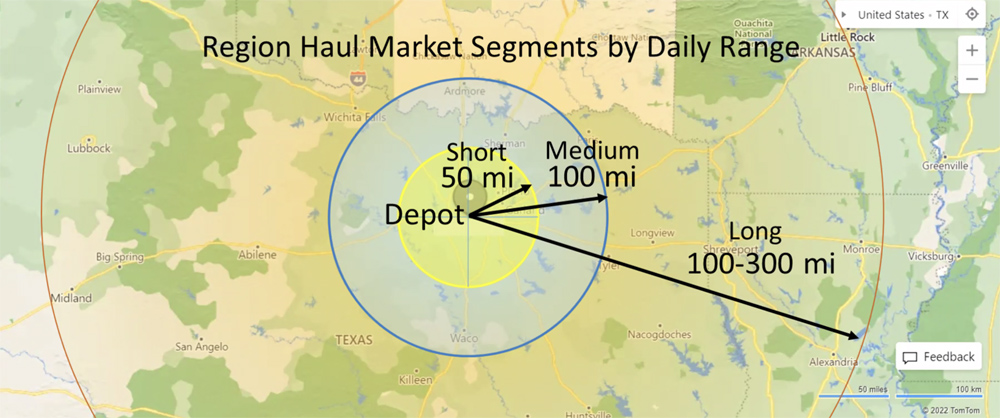
Four companies in California running large Class 8 trucks on regional daily routes — (clockwise from top left) Anheuser-Busch, Biagi Brothers, Penski and NFI — tested electric versions of familiar tractors last fall.
| NACFEIf half of the nation’s heavy duty regional-haul tractor trailers were electric rather than diesel, annual carbon dioxide emissions would be slashed by more than 29 million metric tons, a new report concludes.
The report released by the North American Council for Freight Efficiency (NACFE) on Thursday also endorsed the immediate feasibility of electrifying some short-haul fleets — from beverage and grocery delivery trucks to general freight — despite their shorter range of about 200 miles and a freight “penalty” of 3,000 to 4,000 lbs. compared with diesels because of their batteries.
NACFE projected the emission reductions using data collected electronically in real-time last fall from four new battery-electric tractor trailers running their usual routes in California.
“The vehicle operations were continuously digitally tracked, and their metrics updated daily via a public website with the ability to view results by day or over a span of days,” NACFE said in the report.
“Metrics such as daily range, speed profiles, state of charge, charging events, amount of regenerative braking energy recovery [recharging the battery], weather and number of deliveries were shown in near real time. Information on weather conditions was also observed,” the report states.
NACFE found that “many people mistakenly assume Class 8 heavy-duty tractors are used in mostly long-haul disparate routes. In fact, only 40% are used in long-haul and 30% are vocational trucks and regional haul tractors respectively. These regional haul tractors are good candidates for electrification due to their shorter daily distances and return-to-base operations.”

And while the sticker price on the trucks can be more than twice that of a comparable diesel, the annul fuel costs of the electrics are drastically lower — $11,200 for electricity versus $20,500 for diesel fuel.
The bottom line of the report?
“Heavy-duty regional haul battery electric trucks are viable solutions today for improving fleet freight efficiency and helping achieve sustainability goals on short and some medium length routes where daily mileage is 200 miles, with one shift return-to-base operations, where overnight vehicle dwell time allows for lower cost overnight charging.”
In other words, about half of the short-haul big trucks on the nation’s highways making daily runs amounting to a total of 200 miles or less could be replaced today.
Despite the overall favorable finding of the test runs and analytical conclusions, the report cautions that the technology underlying electric trucks — and the scarcity today of public fast-charging stations — is a limiting factor on an immediate transformation of trucking fleets.
The analysis is based on the performance of four Class 8 trucks built either by traditional diesel truck makers Freightliner, Volvo VNR and Peterbilt, or newcomer BYD, according to the report.
“All performed as expected but as of 2021 did not have the range to complete the full day’s work of their diesel incumbents,” the report cautions.
If fast-charging stations were built, as more than 50 utilities have pledged as a goal along the nation’s interstate system, these electric trucks could be more quickly adopted, the report adds.
“We … consider this market segment to be 50% electrifiable today,” NACFE said.


